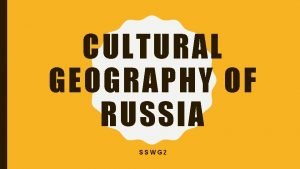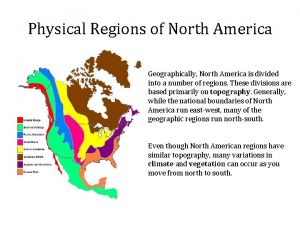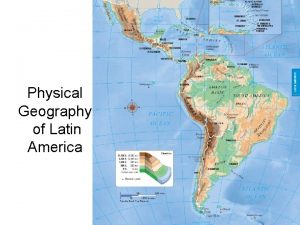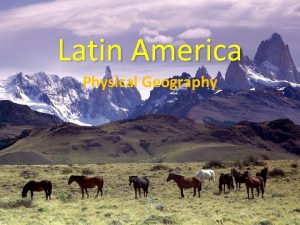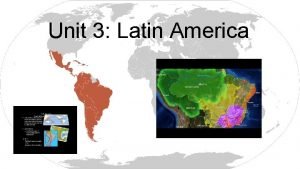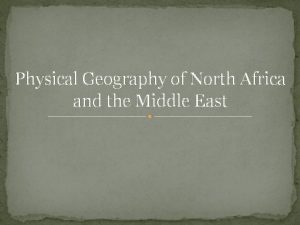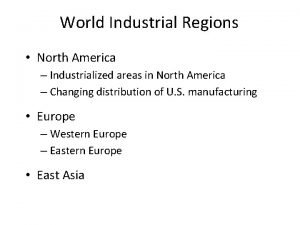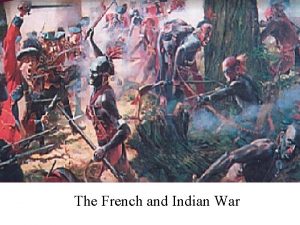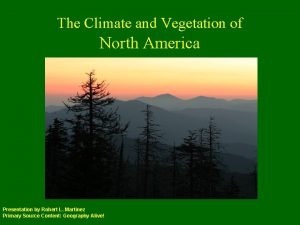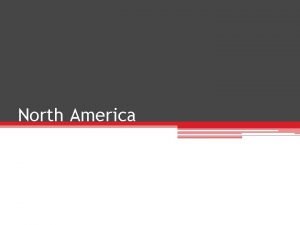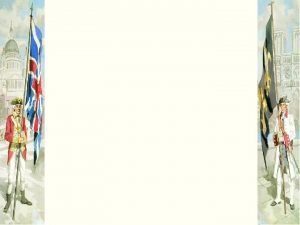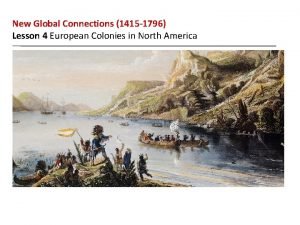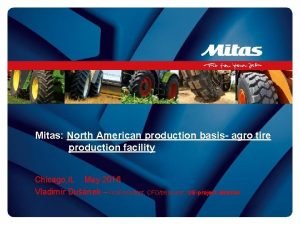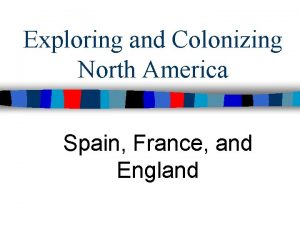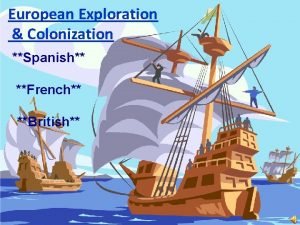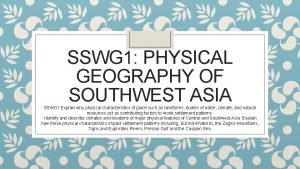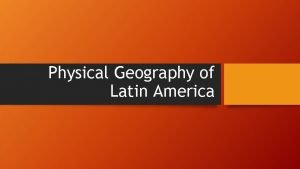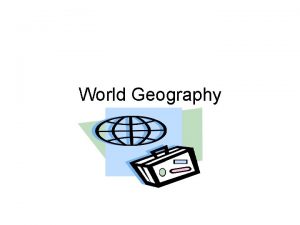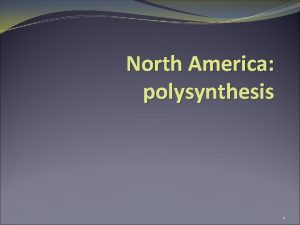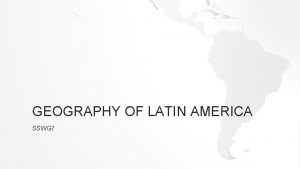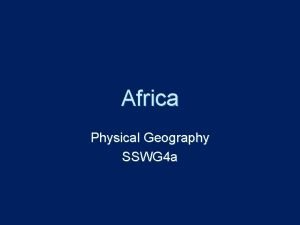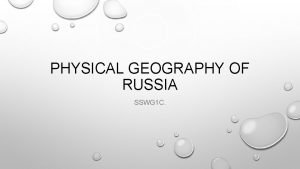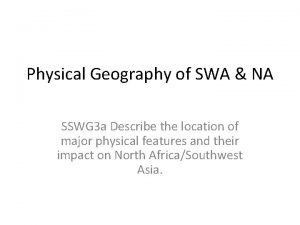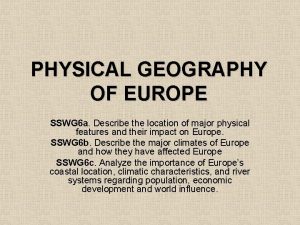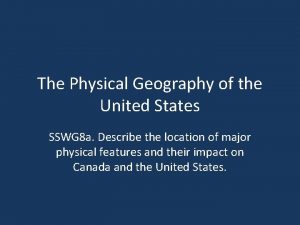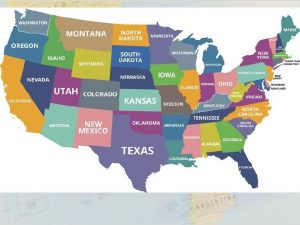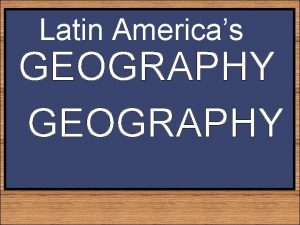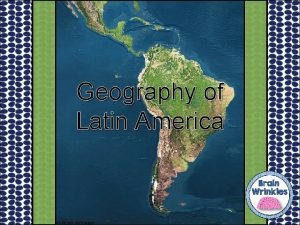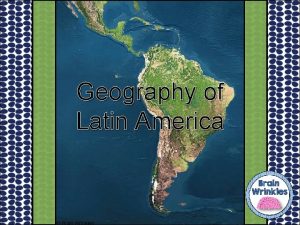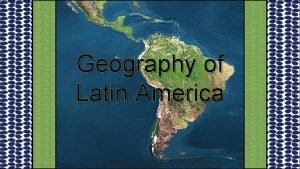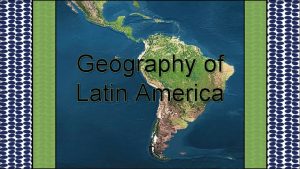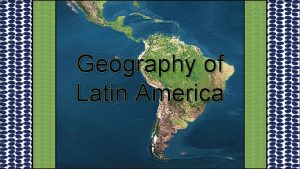Physical Geography of North America SSWG 1 Explain



























- Slides: 27

Physical Geography of North America SSWG 1 Explain why physical characteristics of place such as landforms, bodies of water, climate, and natural resources act as contributing factors to world settlement patterns. a. Identify and describe climates and locations of major physical features of North America. Explain how these physical characteristics impact settlement patterns including, but not limited to, the Mississippi River System, the Appalachian and Rocky Mountains, and the Canadian Shield h. Describe the spatial distribution of natural resources, including, but not limited to, fuel and energy, agricultural, and mineral sources. Predict how distribution of natural resources continues to impact global settlement patterns. .

Landforms & Resources

Vast Lands – Atlantic Ocean (East) & Pacific Ocean (West) – Arctic Ocean (North) & Gulf of Mexico (South) – 1/8 land surface of world Country Size (land area sq. km) Russia 16 million Canada 14 million United States 9 million

Abundant Resources – Fertile soils – Lots of water – Large deposits of minerals


The Eastern Lowlands – Flat, coastal plain along Atlantic Ocean & Gulf of Mexico – 3 subregions – Atlantic Coastal Plain – Gulf Coastal Plain – Piedmont

The Appalachian Highlands – Appalachian Mountains: extend 1, 600 miles from Newfoundland to Alabama – Oldest, soft peaks

The Interior Lowlands – Lowlands, rolling hills, lakes, rivers, fertile soil – 3 subregions – Interior Plains – Canadian Shield: flat, rock region covering nearly 2 million square miles & encircling Hudson Bay – Great Plains: vast, treeless grassland

The Western Mountains, Plateaus & Basins – Rocky Mountains: extends 3, 000 miles from Alaska south to New Mexico – Young, jagged peaks – Continental Divide: line of highest points in the Rockies marking the separation between rivers flowing eastward & westward – North America’s Highest Peak = Mt. Mc. Kinley – Pacific Mountain Ranges, Steep Cliffs, Deep Canyons, Lowland Desert Areas (Basins)

The Islands – Canada’s northernmost lands = icy islands near Arctic Circle – Greenland = Largest North American Island – Aleutian Islands – coastal Alaska – Hawaii – geographically not part of North America, but central Pacific – Politically, part of North America

Natural Resources

Resources Shape Ways of Life – Landforms of U. S. /Canada = variety & abundance of natural resources – Leading agricultural & industrial nations – Why?


Oceans & Waterways – 3 oceans = Atlantic, Pacific, Arctic – Gulf of Mexico (U. S. ) – Shipping & fishing Industries – Inland rivers, lakes – Transportation, hydroelectric power, irrigation, fresh water, fisheries – Great Lakes: Huron, Ontario, Michigan, Erie, Superior – Along with St. Lawrence Seaway world’s major shipping routes

Oceans & Waterways – Continent's longest & busiest river system is the Mississippi-Missouri-Ohio – Mackenzie River = Canada’s longest river – Flows across Northwest Territories to the Arctic Ocean

Land & Forests – Fertile soils – World’s leading food exporter – Agricultural land found in plains & river valleys – ½ Canada, 1/3 U. S. = forests & woodlands

Minerals & Fossil Fuels – Iron ore, nickel, copper, gold, uranium = Canadian Shield – Gold, silver, copper, uranium = Western Mountains – Coal, natural gas, oil, well-developed networks for transport of goods – U. S. is major importer of energy resources

Climate & Vegetation



Shared Climate Zones – Northwestern Canada & Alaska = frigid winter temperatures – Canada/U. S. Border – U. S. has more climate zones = extends over larger north to south area – U. S. more mild = closer to mid-latitudes – Canada much colder = closer to high latitudes

Colder Climates – Arctic coast of Alaska/Canada = tundra – Long/bitterly cold winters & short/chilly summers – Huge, treeless plain – Rest of Canada – subarctic climate – Cold winters, short & mild summers – Vast forest of needle-leafed evergreens – Permafrost = permanently frozen ground

Colder Climates – Rocky Mountains & Pacific Ranges = highland climate & vegetation – Colder, little vegetation at higher altitudes – Mountains = rainy west side, dry east side

Moderate Climates – Humid Continental = north central, northeastern U. S. & southern Canada – Cold winters, warm summers – Good Climate & soil = agriculturally productive (dairy, grain, livestock) – Deciduous & needle-leaf evergreen trees – Forests east of Mississippi, template grasslands to the west – Marine West Coast = northern California to Southern Alaska – Moderately warm summers – Long, mild, rainy, foggy winters – Deciduous trees, evergreens, giant California redwoods

Milder Climates – Humid subtropical = southern U. S. – Hot, muggy summers – Mild & cool winters – Moist air from the Gulf of Mexico = rain during winter – Mild climate & adequate rainfall = agriculturally productive – Mediterranean Climate = central & southern coasts California – Dry, sunny & warm summers – Mild & somewhat rainy winters – Long growing season & irrigation = rich farming area for fruits & vegetables

Dry Climates – Semiarid Climate = Great Plains & dry northern parts of the Great Basin – Little rain = short grasses & Shrubs – Desert = southwest U. S. – Hot & Dry – Cacti, barren rock or sand – Ex: Mojave Desert

Tropical Climates – Tropical climates = Hawaii & southern Florida – Lush rain forests (Hawaii) – Wet & Dry seasons (Florida) – Always warm (no less than 70 degrees) – Tall grasses & scattered trees – Everglades: huge swampland
 Cultural geography of russia
Cultural geography of russia America vs africa
America vs africa 8 physical regions of north america
8 physical regions of north america Middle america
Middle america Web quest: geography of the spanish speaking world
Web quest: geography of the spanish speaking world Physical geography of latin america
Physical geography of latin america Lesson 1 latin america africa and the middle east
Lesson 1 latin america africa and the middle east Chapter 8: the physical geography of latin america answers
Chapter 8: the physical geography of latin america answers Amazon river
Amazon river Physical geography of north africa
Physical geography of north africa Lesson 1 physical geography of southeast asia
Lesson 1 physical geography of southeast asia Kums definition geography
Kums definition geography We can do a rap of the map of the us
We can do a rap of the map of the us Repetition in let america be america again
Repetition in let america be america again Why is it called latin america
Why is it called latin america Happening body art
Happening body art New industrial regions
New industrial regions Why are cold fronts steeper than warm fronts
Why are cold fronts steeper than warm fronts North america 1754
North america 1754 Vegetation of north america
Vegetation of north america Ottawa on map of north america
Ottawa on map of north america Yucatan peninsula on map of south america
Yucatan peninsula on map of south america Great plains of canada
Great plains of canada North america map 1750
North america map 1750 European colonies in north america
European colonies in north america Mitas tires north america inc
Mitas tires north america inc European colonization of americas
European colonization of americas European colonies in north america
European colonies in north america
